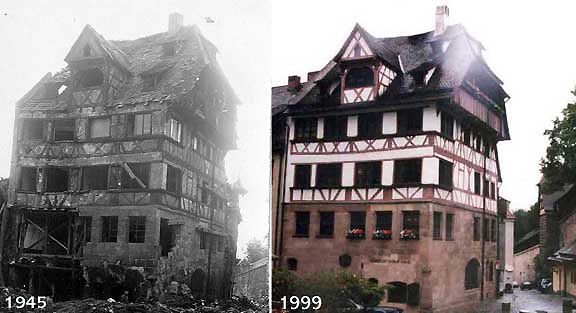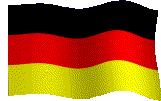 Nürnberg
Nürnberg

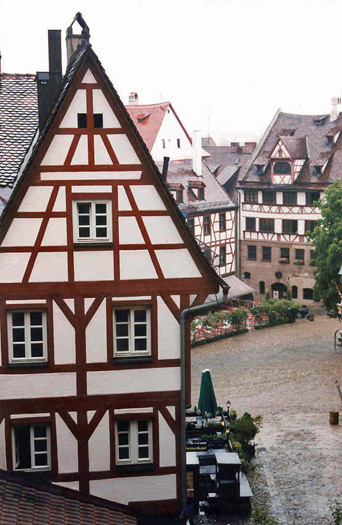 In 1999, as we
drove
through Southern Germany on our honeymoon, we stopped for three days in
Heidelberg. After leaving
Heidelberg, we drove to München (or in English - Munich) in
Bavaria. On
our way to München, we stopped in Nürnberg for the afternoon. We
were here only for a few hours and it rained the whole time we were
there. The rain, however, didn't keep us from having lunch and
exploring the city.
In 1999, as we
drove
through Southern Germany on our honeymoon, we stopped for three days in
Heidelberg. After leaving
Heidelberg, we drove to München (or in English - Munich) in
Bavaria. On
our way to München, we stopped in Nürnberg for the afternoon. We
were here only for a few hours and it rained the whole time we were
there. The rain, however, didn't keep us from having lunch and
exploring the city.Nürnberg (or Nuremberg) is an old city. It is the largest city in the region of Franconia and second in size in the state of Bavaria to München. It is situated on the Pegnitz river and the Rhine–Main–Danube Canal. The city is about 965 years old and one of the most historic cities in Germany full of half-timbered houses. As the city grew in the Middle-ages, the citizens built large walls with towers and moats around Nürnberg. These massive Medieval walls and towers, finished in 1452, still stand today. Unfortunately, much of the city was destroyed during the Second World War. However, they have done a great job restoring the city.
When we arrived, we parked the car in the Hauptbahnhof (train station) parking garage. We walked along the outside of the old city walls to one of the gate houses that lead into the Altstadt or Old City. We entered the Altstadt along the Kartäusergaße, next to the Germanisches Nationalmuseum. This is the southern part of the Old City which is called the Lorenz Quarter. The Old City is divided into two quarters, divided by the Pegnitz River and is named after its main parish church.
Built in an old Carthusian Monastery in 1852, the Germanisches Nationalmuseum is the largest cultural museum in Germany with over 1.2 million objects. The old monastery part is inside the museum. From where we walked, you could only see the modern buildings built in the 1950's and 1960's. It would take you almost a whole day to walk through it. However, since we didn't have a whole day, we just walked by.
History of Nürnberg First
mentioned in 1050 as "Nourenberc", Nürnberg received a charter in 1219 and was
made a free imperial city by the end of the 13th century. The city was
independent of the burgraviate of Nürnberg, which included a large part of
Franconia and which came under the control of the Hohenzollern family
in 1192. Nürnberg soon became, with Augsburg, one of
the two great trade centers on the route from Italy to Northern Europe.
In the 14th century, Nürnberg was proclaimed a Free Imperial
City. In 1356, Emperor Charles IV stipulated in the "Golden Bull" that
every emperor must hold his first Imperial Diet in Nürnberg. The Nürnberg merchants, the so-called "moneybags
", and the city's
immensely skilled artisans secured Nuremberg's outstanding position in
the Middle Ages. Nuremberg
is often referred to as having been the 'unofficial capital' of the
Holy Roman Empire, particularly because Reichstage (Imperial Diets) and courts met at
Nuremberg Castle.
First
mentioned in 1050 as "Nourenberc", Nürnberg received a charter in 1219 and was
made a free imperial city by the end of the 13th century. The city was
independent of the burgraviate of Nürnberg, which included a large part of
Franconia and which came under the control of the Hohenzollern family
in 1192. Nürnberg soon became, with Augsburg, one of
the two great trade centers on the route from Italy to Northern Europe.
In the 14th century, Nürnberg was proclaimed a Free Imperial
City. In 1356, Emperor Charles IV stipulated in the "Golden Bull" that
every emperor must hold his first Imperial Diet in Nürnberg. The Nürnberg merchants, the so-called "moneybags
", and the city's
immensely skilled artisans secured Nuremberg's outstanding position in
the Middle Ages. Nuremberg
is often referred to as having been the 'unofficial capital' of the
Holy Roman Empire, particularly because Reichstage (Imperial Diets) and courts met at
Nuremberg Castle.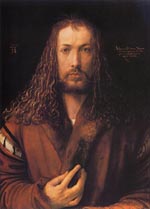 The
cultural flowering of Nürnberg in the 15th and 16th century made it
the center of the German Renaissance. Among the artists who were born
or lived there, the painter Albrecht Dürer (self-portrait at right) was the greatest;
others, such as the sculptors Adam Kraft, Veit Stoss and Peter Vischer,
and the painter and woodcarver Michael Wolgemut, adorned the city with
their works, which brought together the Italian Renaissance and the
German Gothic traditions. The city was also an early center of
humanism, science, printing, and mechanical invention. The scholars
Pirkheimer and Celtes lectured in the city, Koberger set up a printing
press and Regiomontanus an observatory, and the first pocket watches,
known as Nürnberg eggs, were made here around 1500. An
interest in culture on the part of the prosperous artisan class found
expression in the contests of the meistersingers (mastersingers), among
whom the shoemaker-poet Hans Sachs (1494–1576) was the most prominent.
The
cultural flowering of Nürnberg in the 15th and 16th century made it
the center of the German Renaissance. Among the artists who were born
or lived there, the painter Albrecht Dürer (self-portrait at right) was the greatest;
others, such as the sculptors Adam Kraft, Veit Stoss and Peter Vischer,
and the painter and woodcarver Michael Wolgemut, adorned the city with
their works, which brought together the Italian Renaissance and the
German Gothic traditions. The city was also an early center of
humanism, science, printing, and mechanical invention. The scholars
Pirkheimer and Celtes lectured in the city, Koberger set up a printing
press and Regiomontanus an observatory, and the first pocket watches,
known as Nürnberg eggs, were made here around 1500. An
interest in culture on the part of the prosperous artisan class found
expression in the contests of the meistersingers (mastersingers), among
whom the shoemaker-poet Hans Sachs (1494–1576) was the most prominent.In 1525, Nürnberg accepted the Protestant Reformation, and the religious Peace of Nürnberg, by which the Lutherans gained important concessions, was signed here in 1532. In the Thirty Years War, King Gustavus II of Sweden was besieged in Nürnberg by Wallenstein in 1632. In 1649, at the end of the Thirty Years War, the funds of the once prosperous city were exhausted. The Napoleonic invasion accelerated this decline. In 1806, Nuremberg lost its charter as a Free Imperial City and was incorporated in the Kingdom of Bavaria. This, however, soon proved to be a blessing in disguise, as the city rapidly developed, becoming the largest industrial center in Bavaria. In 1806, Nürnberg became part of Bavaria. A symbol of this new ascent was the opening in 1835 of Germany's first railway line from Nürnberg to nearby Fürth. After Adolf Hitler came to power, Nürnberg was made a national shrine by the National Socialists Party or Nazis, who held their annual party congresses nearby from 1933 through 1938. The city was the home of the Nazi leader Julius Streicher and became a center of anti-Semitic propaganda. At the party congress of 1935 the so-called Nürnberg Laws were promulgated; they deprived German Jews of civic rights, forbade intermarriage between Jews and non-Jews and deprived persons of partly Jewish descent of certain rights. Until 1945, Nürnberg was the site of roughly half the total German production of airplane, submarine, and tank engines; as a consequence, the city was heavily bombed by the Allies during World War II and was largely destroyed. After the war, Nürnberg was the seat of the international tribunal for war crimes. Some of the top Nazi's were put on trial here for crimes against humanity. Among those on trial was Julius Streicher, who was found guilty and later hanged. Today, Nürnberg is a modern city, the 14th largest in Germany, with 500,132 people, and the second largest in Bavaria. It is in the process of transforming itself from an industrial city to a technology-based service center. Like everywhere else in Germany, football or fußball (soccer) is the main sport. The local professional fußball team is FC Nürnberg (Fußball Club Nürnberg), locally as Der Club, who wear red shirt and black shorts and play in the 44,600  seat Franken-Stadion.
Begun in 1900, FC Nürnberg,
also known as "der Club",
had been one of Germany's more successful clubs. They have won nine
national titles, however, six of them were between the wars and another
right after. Their last title came in 1968 after which their coach Max Merkel dismantled the team which started a long
period of decline. Germany honors its Bundesliga champions by allowing
them to display the gold stars of the "Verdiente Meistervereine" – one
star for three titles, two stars for five, and three stars for ten.
However, currently only titles earned since 1963 in the Bundesliga are
officially recognized. Despite winning the national title nine times,
Nuremberg – the country's second most successful team – is not entitled
to sport any championship stars. seat Franken-Stadion.
Begun in 1900, FC Nürnberg,
also known as "der Club",
had been one of Germany's more successful clubs. They have won nine
national titles, however, six of them were between the wars and another
right after. Their last title came in 1968 after which their coach Max Merkel dismantled the team which started a long
period of decline. Germany honors its Bundesliga champions by allowing
them to display the gold stars of the "Verdiente Meistervereine" – one
star for three titles, two stars for five, and three stars for ten.
However, currently only titles earned since 1963 in the Bundesliga are
officially recognized. Despite winning the national title nine times,
Nuremberg – the country's second most successful team – is not entitled
to sport any championship stars.They qualified for the European Cup (for-runner of the current UEFA Champions League - a prestigious championship of the most successful football clubs in Europe which was inaugurated in 1955) in 1961-62. After winning five straight games, they were eliminated 6-0 by eventual winners Benfica of Libson, Portugal. They qualified for their second and last time in 1968 but lost in the first round to eventual champions Ajax of Amsterdam. In 2007, Der Club has rebounded, winning the German Cup. In 2008, they were relegated to the 2nd level, but the following year in 2009, with its new coach, Dieter Hecking, they are back in Germany's top soccer level, 1st Bundesliga. On Bavarian scale, the games against FC Bayern Munich are the biggest events of the year, the two clubs being the most successful sides in the state. FC Nürnberg plays in Germany's top division, but doesn't usually see much success, they have been dropped (relegated) to the second division seven times, more than any onther German team. One of Germany's top goaltenders Andreas Köpke played for FC Nürnberg. 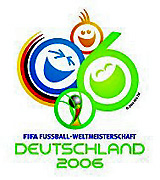 Germany is hosting
the 2006 World Cup (Weltmeisterschaft) and Nürnberg's Franken-Stadion
is one of the site for games to be
played. This is the second
time the World Cup has come to Germany. West Germany hosted it back in
1974 but none of the game were played in Nürnberg. In 2006, they will
host four 1st Round games, including the U.S.A. against Ghana, and one
2nd Round Game. Nürnberg first ever World Cup game was played
on June 11, 2006 and saw Mexico defeat Iran 3 to 1. Built in less then
three years in
1928, the Municipal Stadium sat 50,000. When the Nazi Party came to
power in 1933, the stadium, which was adjacent to Zeppelin Field where
the Nazi's held their massive rallys, was called "Stadion der Hitler-Jugend" (Hitler Youth Stadium)
and was also used for party rallies. After Nürnberg was captured by the U.S. Army in 1945, the name
was changed back. The
stadium was renovated in 1961 and again in 1991 when it was given it's
current name. In 1967, the Franken-Stadion was the site of the
European Cup Championship game where FC Bayern München defeated the Glasgow Rangers. Of course, like
all over America where sports stadiums are being re-named after
corporations, it's no different here. In 2006, they renamed it
easyCredit-Stadion.
Germany is hosting
the 2006 World Cup (Weltmeisterschaft) and Nürnberg's Franken-Stadion
is one of the site for games to be
played. This is the second
time the World Cup has come to Germany. West Germany hosted it back in
1974 but none of the game were played in Nürnberg. In 2006, they will
host four 1st Round games, including the U.S.A. against Ghana, and one
2nd Round Game. Nürnberg first ever World Cup game was played
on June 11, 2006 and saw Mexico defeat Iran 3 to 1. Built in less then
three years in
1928, the Municipal Stadium sat 50,000. When the Nazi Party came to
power in 1933, the stadium, which was adjacent to Zeppelin Field where
the Nazi's held their massive rallys, was called "Stadion der Hitler-Jugend" (Hitler Youth Stadium)
and was also used for party rallies. After Nürnberg was captured by the U.S. Army in 1945, the name
was changed back. The
stadium was renovated in 1961 and again in 1991 when it was given it's
current name. In 1967, the Franken-Stadion was the site of the
European Cup Championship game where FC Bayern München defeated the Glasgow Rangers. Of course, like
all over America where sports stadiums are being re-named after
corporations, it's no different here. In 2006, they renamed it
easyCredit-Stadion. 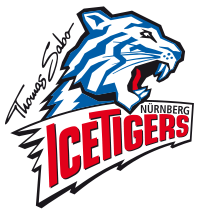 Nürnberg also
has a professional ice hockey team, the Nürnberg Ice Tigers. Professional ice hockey in Germany is
not
as well organized as it is in many other countries. The Ice Tigers,
originally called the EHC
80 Nürnberg (established in 1980), play in Germany's top league, the Deutsche Eishockey Liga or DEL (established in 1995)
being one of the original 18 founding members (today the league has 14
members). They play in the modern 8,200 seat Arena Nürnberg (opened
in 2001) across the street from the Franken-Stadion
(easyCredit-Stadion). They used to play in the old Linde Stadion which hosted the 1936 Olympic hockey
games (torn down in 2001). In the 1990's, they didn't finish well and
never won a championship. However, in 1999, they finished in first
place, unfortunately they lost in the finals to the Adler Mannheim Eagles. Since 2001, they have been
doing very well, but somehow lose every year in the quarter-finals.
Nürnberg also
has a professional ice hockey team, the Nürnberg Ice Tigers. Professional ice hockey in Germany is
not
as well organized as it is in many other countries. The Ice Tigers,
originally called the EHC
80 Nürnberg (established in 1980), play in Germany's top league, the Deutsche Eishockey Liga or DEL (established in 1995)
being one of the original 18 founding members (today the league has 14
members). They play in the modern 8,200 seat Arena Nürnberg (opened
in 2001) across the street from the Franken-Stadion
(easyCredit-Stadion). They used to play in the old Linde Stadion which hosted the 1936 Olympic hockey
games (torn down in 2001). In the 1990's, they didn't finish well and
never won a championship. However, in 1999, they finished in first
place, unfortunately they lost in the finals to the Adler Mannheim Eagles. Since 2001, they have been
doing very well, but somehow lose every year in the quarter-finals. During the 2008–09 season it became obvious that the Ice Tigers were in a dire financial situation. On November 25, 2008, preliminary insolvency was filed and on December 30, 2008, declared. This led to the corporate sponsor Bionorica pulling their support in March 2009. An investor group lead by local Jeweler Thomas Sabo interveened on April 3, 2009, preempting bankruptcy proceedings and ensuring participation in the 2009–10 season. The team is now known as Thomas Sabo Ice Tigers. |
From there we entered the Kornmarkt. It began to rain hard, so we, and everyone else, stayed under cover for a little while. It eventually slowed down and we continued our walk. We walked to a large open plaza next to St. Lorenz Kirche (St. Lawrence's Church). Begun in 1270, St. Lorenz Kirche took more than 200 years to complete. St. Lorenz Kirche is considered one of the more beautiful churches in Nürnberg and is an important part of the Nürnberg skyline with it's twin spires flanking the main west doorway. The doorway's sculptures depict the theme of redemption, from Adam and Eve through the Last Judgment.
Like other churches in Nürnberg and Germany, the choir is considerably higher than the nave and aisles. This means that internally, the choir is brighter, lit by taller windows than the remainder of the church. The choir was the last portion of the church to be completed in 1477. St. Lorenz Kirche has a fine interior with many sculptures. Like everything else in Nürnberg, St. Lorenz Kirche was badly damaged during the Second World War, though the main structure including the towers remained intact.
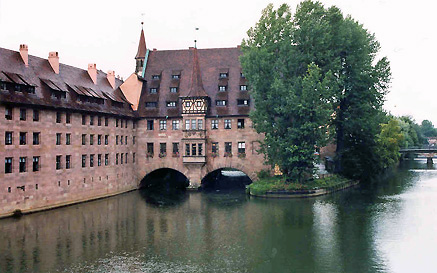 Debbie
and I
continued our walk down Konigstraße to the Pegnitz
River which cuts
through the center of the Altstadt. We crossed the Museumsbrücke (museum bridge) just to the west of the
Hellig Geist Spital (Hospital of the Holy Spirit). This is a very
picturesque place (even on a rainy day). You can get a great picture of
this beautiful 15th century building built out over the river. The
Hellig Geist Spital was founded in 1332 by Konrad
Gross, a wealthy patrician,
for the care for the elderly and needy. It was the largest private
endowment in the Holy Roman Empire up to 1500. and the wing in the photo that
spans the river was added
between 1488 and 1527. The main complex features a lovely courtyard
with wooden galleries overlooking it. The building was badly
damaged during
the Second
World War destroying everything above the roof level.
Debbie
and I
continued our walk down Konigstraße to the Pegnitz
River which cuts
through the center of the Altstadt. We crossed the Museumsbrücke (museum bridge) just to the west of the
Hellig Geist Spital (Hospital of the Holy Spirit). This is a very
picturesque place (even on a rainy day). You can get a great picture of
this beautiful 15th century building built out over the river. The
Hellig Geist Spital was founded in 1332 by Konrad
Gross, a wealthy patrician,
for the care for the elderly and needy. It was the largest private
endowment in the Holy Roman Empire up to 1500. and the wing in the photo that
spans the river was added
between 1488 and 1527. The main complex features a lovely courtyard
with wooden galleries overlooking it. The building was badly
damaged during
the Second
World War destroying everything above the roof level. If you are wondering what the symbol "ß" is. It is called an "Eszett" and is pronounced like a double "s". In addition, the word Straße or Strasse is, if you haven't already guessed, the
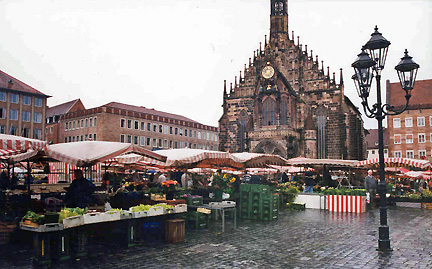 German word for street.
German word for street.After crossing the river, we had entered the Sebald Quarter of the Old City. We continued walking north to the Hauptmarkt. This is Nürnberg's main market square and the heart of the city. During the days of the Third Reich, the square was renamed, "Adolf Hitler Platz," but it was changed back shortly after the U.S. Army arrived in town in 1945. As you can see from the photo, it was market day when we were here. They don't let a little rain stop them. In the back you can see the Frauenkirche (Our Lady's Church) which borders the east side of the square. It was heavily damaged in World War II, losing windows and it's roof (there is a photo below), but has been restored. In December, the "Christkindlmarkt" or Christ-child market is held here, with exhibits of Christmas toys and decorations.
The late-Gothic Frauenkirche (Church of Our Lady) was built, with the approval of the Holy Roman Emperor Charles IV, in 1350. It was built out of redstone blocks and stands
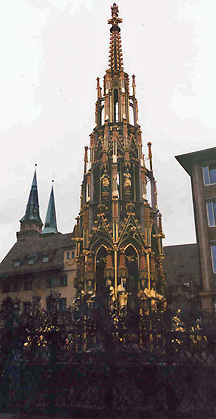 as
a perfect example of German Gothic architecture. It was built on the
site of a
synagogue that was destroyed during a pogrom in 1349. The second Nürnberg synagogue on Hans Sachs Platz was
the first one destroyed by the Nazi's in 1938, three days before
Kristallnacht. A memorial depicting the 19th century Moorish style
synagogue is all that remains on the site. The
church was also badly damaged in the bombings which destroyed all of
the buildings near it. All the other buildings around the square were
built after the
war.
as
a perfect example of German Gothic architecture. It was built on the
site of a
synagogue that was destroyed during a pogrom in 1349. The second Nürnberg synagogue on Hans Sachs Platz was
the first one destroyed by the Nazi's in 1938, three days before
Kristallnacht. A memorial depicting the 19th century Moorish style
synagogue is all that remains on the site. The
church was also badly damaged in the bombings which destroyed all of
the buildings near it. All the other buildings around the square were
built after the
war.One of the best features of the Frauenkirche is the Mannleinlaufen. This is a clock that is set in the facade that was installed back in the year 1500. Below the clock is a mechanical show that appears everyday at noon. When the clock strikes 12, the electors of the Holy Roman Empire come out and bow to Emperor Charles IV.
In the center of the Hauptmarkt is the Gothic Schöner Brunnen, which in German means, Beautiful Fountain (photo at left). The original was erected in 1385, but was replaced by a replica in the early 20th century (the original fountain is kept in the Germanisches Nationalmuseum). It has a sixty-two foot spire set into an octagonal pool. The pool is decorated with statues of philosophers, evangelists and church fathers. The spire is decorated with statues of Electors, along with Jewish and Christian heroes. Set into the railings is a golden ring. According to local legend, if you turn it three times, your wishes will come true. Or so they say. Unfortunately, because the day was cloudy and somewhat dark, I was not able to get a great photo of the fountain.
| The Bombing of Nürnberg Since Nürnberg was the national shrine of the Nazi Party, it naturally became a target of Allied bombings during the Second World War. This caused massive destruction of the old Medieval city. 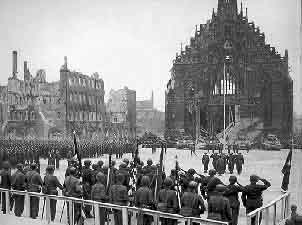 The
citizens of Nürnberg suffered through 38 air raids
during the war. One of
the worst was on the night of January 2, 1945, when 525 British
Lancaster bombers destroyed or damaged most of the old city, including
the medieval walls, castle and 13th century Gothic churches. At that
point in the war, it was the most devastating air-raid attack on a
civilian population and only the bombing of Dresden, a month later,
caused more damage and civilian deaths in Germany. In just one hour, they dropped
6,000 high explosive bombs and one million incendiary bombs. 2,000
citizens lost their lives that night and another 100,000 were homeless.
The old
sections of Nürnberg were completely destroyed (39% of
all buildings completely vanished and another 52% were heavily
damaged). The castle and old churches were bombed out. Overall Nürnberg was the most destroyed city in all
of Germany after Dresden. After the war, the people of Nürnberg set out to rebuild their city. The
Frauenkirche is in the right of the picture next to the Hauptmarkt on April 20, 1945, with
the U.S. 45th Infantry Division reviewing troops after capturing the
city. You can some tanks in the background near the church. This was
also Hitler's birthday and ten days before he would commit suicide. My photo above shows what it looks like
today. The
citizens of Nürnberg suffered through 38 air raids
during the war. One of
the worst was on the night of January 2, 1945, when 525 British
Lancaster bombers destroyed or damaged most of the old city, including
the medieval walls, castle and 13th century Gothic churches. At that
point in the war, it was the most devastating air-raid attack on a
civilian population and only the bombing of Dresden, a month later,
caused more damage and civilian deaths in Germany. In just one hour, they dropped
6,000 high explosive bombs and one million incendiary bombs. 2,000
citizens lost their lives that night and another 100,000 were homeless.
The old
sections of Nürnberg were completely destroyed (39% of
all buildings completely vanished and another 52% were heavily
damaged). The castle and old churches were bombed out. Overall Nürnberg was the most destroyed city in all
of Germany after Dresden. After the war, the people of Nürnberg set out to rebuild their city. The
Frauenkirche is in the right of the picture next to the Hauptmarkt on April 20, 1945, with
the U.S. 45th Infantry Division reviewing troops after capturing the
city. You can some tanks in the background near the church. This was
also Hitler's birthday and ten days before he would commit suicide. My photo above shows what it looks like
today. |
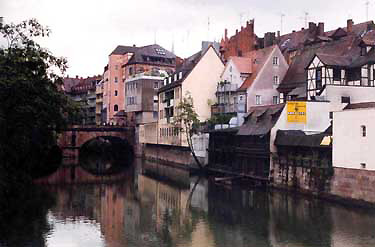 The
Pegnitz River,
seen here, rises near Lindenhard in Upper Franconia (Bavaria) from two
sources. At first it is called the Fichtenohe, but when it reaches the
town of Buchau it's name changes to the Pegnitz. It continues
flowing in a south-westerly direction disappearing below the small town
of Pegnitz into a mountain cavern. It re-appears and flows into Middle
Franconia through the center of Nürnberg. The Pegnitz continues flowing east until it
reaches the Pegnitz River near the city of Fürth. The Pegnitz
flows north to the city of Bamberg where it flows into the Main River.
The
Pegnitz River,
seen here, rises near Lindenhard in Upper Franconia (Bavaria) from two
sources. At first it is called the Fichtenohe, but when it reaches the
town of Buchau it's name changes to the Pegnitz. It continues
flowing in a south-westerly direction disappearing below the small town
of Pegnitz into a mountain cavern. It re-appears and flows into Middle
Franconia through the center of Nürnberg. The Pegnitz continues flowing east until it
reaches the Pegnitz River near the city of Fürth. The Pegnitz
flows north to the city of Bamberg where it flows into the Main River.
These two pictures were taken from the bridge off Hauptmarktstraße
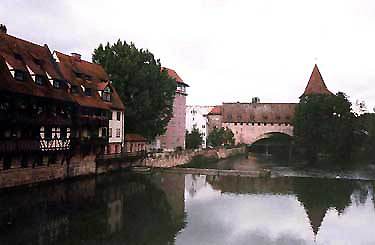 and looking east (top) and west
(bottom). The top-left picture shows the southern part of
the Museumsbrücke (museum
bridge) which we crossed when we entered
the Sebald
Quarter and I took the
picture of the Hellig Geist Spital (Hospital of the Holy Spirit) which
is just beyond
the bridge in the photo. I found the jumbled collection of houses along
the river to be interesting. The bridge in the photo at right is west
of the Hauptmarktstraße bridge and is looking at the Karlsbrücke.
and looking east (top) and west
(bottom). The top-left picture shows the southern part of
the Museumsbrücke (museum
bridge) which we crossed when we entered
the Sebald
Quarter and I took the
picture of the Hellig Geist Spital (Hospital of the Holy Spirit) which
is just beyond
the bridge in the photo. I found the jumbled collection of houses along
the river to be interesting. The bridge in the photo at right is west
of the Hauptmarktstraße bridge and is looking at the Karlsbrücke.Nuremberg has one of the largest pedestrian zones (called Fußgangerzone) in Germany, covering roughly 70% of the Altstadt. This makes walking around very pleasant since you can casually stroll without having to dodge cars.
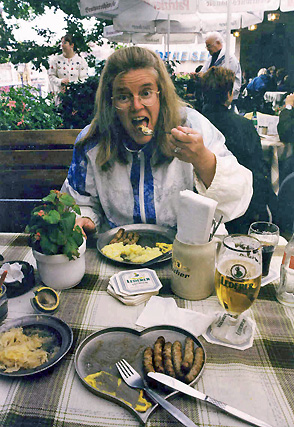 Debbie and I
decided to stop for lunch. We ate in an outdoor cafe on the Burgstraße
next to the back of St. Sebaldus Kirche. It was only lightly
drizzling at the time and the umbrellas over our table kept us
relatively dry. We had a local favorite, Nürnberger Bratwursttag, which were served on pewter plates
shaped like hearts (as you can see in the photo). They are unique to
the city. They are smaller and thinner then your average bratwurst and
are grilled over open fires. They came with
sauerkraut and potatoes (of, course)
and I enjoyed the local Lederer
beer while Debbie had a Coke (as
usual). I am told that all of the ingredients of the Nürnberger Bratwursttag are
secret - though they include fresh marjoram and ground caraway
seeds. They love their bratwurst so much that May 20 in Nürnberg
is "Nürnberger
Bratwursttag Day." The Lederer beer was fine.
Other Nürnberg beers are Barfüßer and
Altstadthof.
Debbie and I
decided to stop for lunch. We ate in an outdoor cafe on the Burgstraße
next to the back of St. Sebaldus Kirche. It was only lightly
drizzling at the time and the umbrellas over our table kept us
relatively dry. We had a local favorite, Nürnberger Bratwursttag, which were served on pewter plates
shaped like hearts (as you can see in the photo). They are unique to
the city. They are smaller and thinner then your average bratwurst and
are grilled over open fires. They came with
sauerkraut and potatoes (of, course)
and I enjoyed the local Lederer
beer while Debbie had a Coke (as
usual). I am told that all of the ingredients of the Nürnberger Bratwursttag are
secret - though they include fresh marjoram and ground caraway
seeds. They love their bratwurst so much that May 20 in Nürnberg
is "Nürnberger
Bratwursttag Day." The Lederer beer was fine.
Other Nürnberg beers are Barfüßer and
Altstadthof.If you are wondering what the symbol "ß" is. It is called an "Eszett" and is pronounced like a double "s". In addition, the word Straße or Strasse is, if you haven't already guessed, the German word for street.
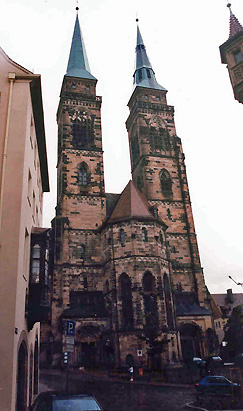 Construction of St. Sebaldus
Kirche
(photo at left) on Albrecht-Dürer-Platz began in 1230s and
was
consecrated in 1273. It is
an excellent example of the
transition from Romanesque to German Gothic styles. Originally built as
a Romanesque basilica with two choirs, it was remodeled during the
14th century. During this, aisles and the western choir were
added. The two towers were completed in the 15th century. Originally a
Catholic church, but it has been a Lutheran parish church since the
Reformation. One of it's prominent
features inside is the Sebaldusgrab, Tomb of St. Sebaldus, a
masterpiece of brasswork by Peter Vischer and his sons. In the silver
coffin are relics of St. Sebaldus (an 8th century hermit and missionary
as well as patron saint of Nuremberg). The coffin rests on figures of
snails and dolphins and all around are figurines of sacred and ordinary
people like the 12 Apostles, St. Sebaldus himself and the artist Peter
Vischer (shown in working attire). Down at the other end of the nave is
a bronze baptismal font, the oldest bronze work in Nürnberg.
Construction of St. Sebaldus
Kirche
(photo at left) on Albrecht-Dürer-Platz began in 1230s and
was
consecrated in 1273. It is
an excellent example of the
transition from Romanesque to German Gothic styles. Originally built as
a Romanesque basilica with two choirs, it was remodeled during the
14th century. During this, aisles and the western choir were
added. The two towers were completed in the 15th century. Originally a
Catholic church, but it has been a Lutheran parish church since the
Reformation. One of it's prominent
features inside is the Sebaldusgrab, Tomb of St. Sebaldus, a
masterpiece of brasswork by Peter Vischer and his sons. In the silver
coffin are relics of St. Sebaldus (an 8th century hermit and missionary
as well as patron saint of Nuremberg). The coffin rests on figures of
snails and dolphins and all around are figurines of sacred and ordinary
people like the 12 Apostles, St. Sebaldus himself and the artist Peter
Vischer (shown in working attire). Down at the other end of the nave is
a bronze baptismal font, the oldest bronze work in Nürnberg. The Church is famous for its organ. The original organ was built in 1441 and was the oldest working organ in the world until its destruction during a bombing raid in January of 1945. The position of organist of St. Sebaldus was the most important one of this kind in Nuremberg, and several important composers occupied this post. Of all the organist, the most famous was Johann Pachelbel.
The church was very badly damaged during the Second World War and has been completely restored. In places it was decided to add new features to replace those which could not be repaired. The sculptures over the two main doorways show an original carving and a new one added during the restoration. The interior is probably the finest in Nürnberg. The view here is of the front (we ate in a cafe on the other side).
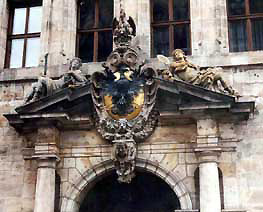 Across
from the
cafe on Burgstraße is the Rathaus (Town Hall). Behind this
Renaissance
palazzo, is an older Gothic Rathaus (Altes Rathaus) built in
1332-40. As Nürnberg
became wealthier and more
important, it was felt
that a new and grander Rathaus (Neue Rathaus) was needed. The new
building was built
between 1616 and 1622. It feature three grand doorways decorated with
heraldic motifs and on a
truly grand scale (one of them is pictured here at left). The building
itself
is quite austere at street level
but as you look upwards, the corner towers, cornice and windows grab
your attention. Most of the building was destroyed in the bombings of
1945 and was later completely rebuilt. Below the Altes Rathaus (old
city hall) is a medieval dungeon, built back in 1332, that is today a
museum called Mittelalterliche
Lochgefängnisse.
Various gruesome instruments of torture are
preserved here. We didn't have the time to visit it on this trip.
Across
from the
cafe on Burgstraße is the Rathaus (Town Hall). Behind this
Renaissance
palazzo, is an older Gothic Rathaus (Altes Rathaus) built in
1332-40. As Nürnberg
became wealthier and more
important, it was felt
that a new and grander Rathaus (Neue Rathaus) was needed. The new
building was built
between 1616 and 1622. It feature three grand doorways decorated with
heraldic motifs and on a
truly grand scale (one of them is pictured here at left). The building
itself
is quite austere at street level
but as you look upwards, the corner towers, cornice and windows grab
your attention. Most of the building was destroyed in the bombings of
1945 and was later completely rebuilt. Below the Altes Rathaus (old
city hall) is a medieval dungeon, built back in 1332, that is today a
museum called Mittelalterliche
Lochgefängnisse.
Various gruesome instruments of torture are
preserved here. We didn't have the time to visit it on this trip.
From here, Debbie and I continued our walking tour towards the northern part of the Altstadt. This part is a bit uphill.
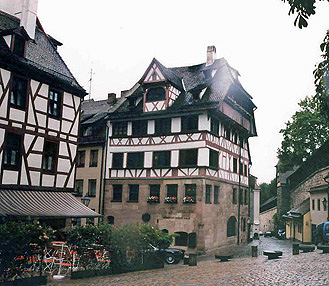 We
walked up to the walled part of
the old castle. As we walked along the wall, we came to the Albrecht
Dürer House. Albrecht
Dürer, was the court painter for Emperor Maximilian I, has been
called the Leonardo da Vinci of Germany, the
ultimate Renaissance man. He was noted for his portrait of
Charlemagne which hangs at the Germanishes National Museum and for his
representation of the Four Apostles at the Nürnberg Rathaus.
Besides paintings, Dürer also did copper and iron engraving and
wood block printing. A native of Nürnberg, Dürer lived here
from 1509
until his
death in 1528. The house was bought by the city in 1828. Typical of the
half-timbered burghers' houses of the 15th century, the structure is
the only completely preserved Gothic house in Nürnberg. The first
floors are sandstone, surmounted by two half-timbered stories and a
gabled roof with a view of the town below. It is now a museum
with
We
walked up to the walled part of
the old castle. As we walked along the wall, we came to the Albrecht
Dürer House. Albrecht
Dürer, was the court painter for Emperor Maximilian I, has been
called the Leonardo da Vinci of Germany, the
ultimate Renaissance man. He was noted for his portrait of
Charlemagne which hangs at the Germanishes National Museum and for his
representation of the Four Apostles at the Nürnberg Rathaus.
Besides paintings, Dürer also did copper and iron engraving and
wood block printing. A native of Nürnberg, Dürer lived here
from 1509
until his
death in 1528. The house was bought by the city in 1828. Typical of the
half-timbered burghers' houses of the 15th century, the structure is
the only completely preserved Gothic house in Nürnberg. The first
floors are sandstone, surmounted by two half-timbered stories and a
gabled roof with a view of the town below. It is now a museum
with 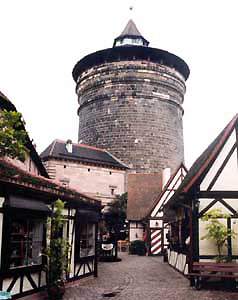 exhibits
inside the house
that are devoted to Dürer 's life and works. Many of the rooms are
furnished
with important historical pieces and contain original etchings and
woodcuts, plus copies of Dürer's paintings. During the Second
World War, a high explosive bomb landed just outside the house, causing
serious
damage but
relative to
other buildings in the city comparatively unscathed. As you can from
the photo, I was having a lot of trouble keeping the camera dry.
exhibits
inside the house
that are devoted to Dürer 's life and works. Many of the rooms are
furnished
with important historical pieces and contain original etchings and
woodcuts, plus copies of Dürer's paintings. During the Second
World War, a high explosive bomb landed just outside the house, causing
serious
damage but
relative to
other buildings in the city comparatively unscathed. As you can from
the photo, I was having a lot of trouble keeping the camera dry.I took some more pictures then Debbie and I started walking back toward the southern end of the Altstadt. I took some more pictures of bridges over the Pegnitz River on the way. We eventually made it back to the train station and our car and continued our trip to München. It was an enjoyable, if not wet afternoon in Nürnberg.
There are some other historical places in Nürnberg that we didn't have the time to visit. Both of them are outside the Altstadt area and walking distance. One of them is the Palace of Justice (Justizgebäude) at Fürtherstraße 22, about two miles west of the Hauptbahnhof (train station). Its a large complex of buildings outside the Altstadt. It was here in 1945 and into 1946 that the Nazi War Crime trials were held. The Palace of Justice where the trial took place, is still being used as a courthouse today. They just started having guided tours (in German) on the weekend that focus on the history of the trial.
| Nürnberg War Trials From November 20, 1945 until October 1, 1946, the International Military Tribunal convened in room 600 in the Nürnberg Palace of Justice. United States Of America Supreme Court Associate Justice Robert H. Jackson, who was the chief prosecutor at the trials, recommended Nürnberg as the site for the trials for several reasons. 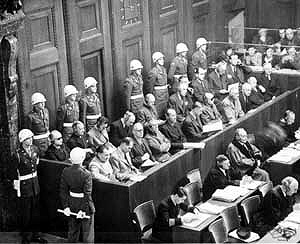 The
Courthouse was big enough to accommodate many people, 530 offices and
about 80 courtrooms. It was well preserved after the war when most of
the city was destroyed. Each of the four Allied Powers (France was now
included ) provided one judge and an alternate; they provided the
prosecutors, too. Among the defendants were Nazi leaders as
Hermann Göring, Rudolf Hess, Julius Streicher, Ernst
Kaltenbrunner, Wilhelm Keitel, Alfred Jodl, Joachim von
Ribbentrop and the architect Albert
Speer. The
Courthouse was big enough to accommodate many people, 530 offices and
about 80 courtrooms. It was well preserved after the war when most of
the city was destroyed. Each of the four Allied Powers (France was now
included ) provided one judge and an alternate; they provided the
prosecutors, too. Among the defendants were Nazi leaders as
Hermann Göring, Rudolf Hess, Julius Streicher, Ernst
Kaltenbrunner, Wilhelm Keitel, Alfred Jodl, Joachim von
Ribbentrop and the architect Albert
Speer. On 218 days of trials, testimony from 360 witnesses was introduced, some verbal, some written and some (236 witnesses) from the court itself. The verdicts were announced on September 30, 1946; three acquittals, 12 sentences to death by hanging, 7 sentences to life imprisonment or to lesser terms. Those sentenced to death were executed in the early morning of October 16, 1946, in the old gymnasium of Nürnberg prison, which was torn down in 1987 as part of a modernization project. The bodies were subsequently cremated in Munich and the ashes were strewn in an estuary of the Isar River. Those sentenced to imprisonment were transferred to the prison in Berlin-Spandau, which the Allies had chosen for this purpose. The last of the prisoners, Rudolf Hess, committed suicide there in August, 1987. Hermann Göring, who had received a death sentence, committed suicide in his jail cell before the sentence could be carried out. Contrary to the original plans, no subsequent international tribunal took place. From 1947 to 1949, twelve U.S. military trials involving politicians, military personnel, businessmen and industrialists, doctors, lawyers, members of the Foreign Office, etc. were held in Nürnberg. Similar trials were also conducted in the French, British and Soviet occupation zones. Link to: The
Nuremberg Trials
|
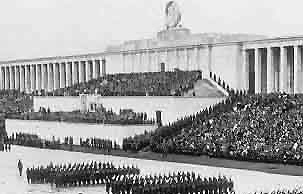 South-east
of the
city is
Zeppelin Field. It was here that the Nazi Party held their gigantic
rally's. Hitler used to make speeches here from the grandiose
grandstand built by Albert Speer, to masses of people numbering in the
tens of thousands. Shortly after Nürnberg was captured by the
United States Army in 1945, they blew up the giant stone swastika which
had been erected above the center of the grandstand (the video of the
explosion has been featured in a number of World War II documentaries).
Today they
hold concerts here, though the grandstand is a bit overrun with weeds.
They also have a museum here called the Documentation Centre Nazi Party
Rally Grounds
(or in German: Dokumentationszentrum Reichsparteitagsgelände)
located in the north wing of the Congress Hall (a building designed by
Albert Speer and planned by the Nazi Party to hold 50,000 people but
was never completed). Next to Zeppelin Field is Franken-Stadion, home of FC Nürnberg, the
professional football (soccer) team.
South-east
of the
city is
Zeppelin Field. It was here that the Nazi Party held their gigantic
rally's. Hitler used to make speeches here from the grandiose
grandstand built by Albert Speer, to masses of people numbering in the
tens of thousands. Shortly after Nürnberg was captured by the
United States Army in 1945, they blew up the giant stone swastika which
had been erected above the center of the grandstand (the video of the
explosion has been featured in a number of World War II documentaries).
Today they
hold concerts here, though the grandstand is a bit overrun with weeds.
They also have a museum here called the Documentation Centre Nazi Party
Rally Grounds
(or in German: Dokumentationszentrum Reichsparteitagsgelände)
located in the north wing of the Congress Hall (a building designed by
Albert Speer and planned by the Nazi Party to hold 50,000 people but
was never completed). Next to Zeppelin Field is Franken-Stadion, home of FC Nürnberg, the
professional football (soccer) team.Debbie and I did not visit either places but instead drove south on toward München. The drive was difficult because of the heavy rain. However, we made it safe and sound to München.
This website was
created on August 20, 2005
Here are a couple of comparison pictures I put together of photos I took on our trip and photos of bomb damage made in 1945 (which I didn't take). Coincidentally, my pictures were taken from similar angles.

